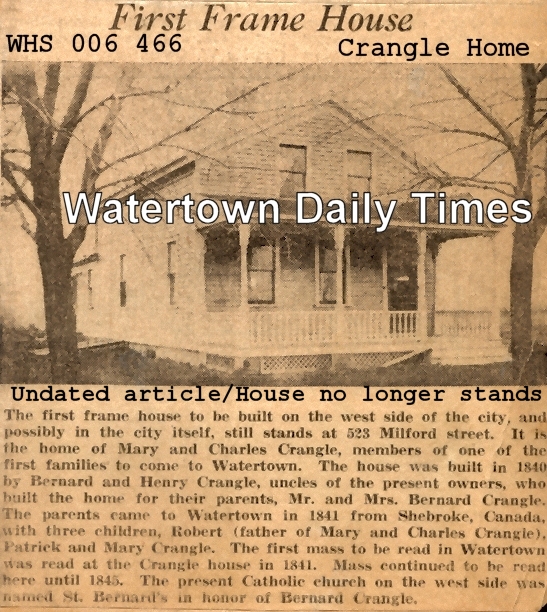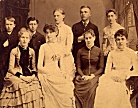website watertownhistory.org
ebook History of Watertown, Wisconsin
Crangle Family
First Mass in Watertown
Founding of St. Bernard’s Catholic Church
Bernard
Crangle and family arrived in Watertown
The
Crangle family had come from Ireland in 1831 and had made their home in
Sherbrooke, Canada, until coming to Watertown.
Two
sons, Bernard, Jr., and Henry had come from Beloit in 1840 and they built the
first frame house in the village as well as a barn, both located south of the
present east-west railroad tracks on the east side of the present-day Milford
Street, directly opposite the Karma manufacturing plant. It was only a short walk to the cabin of
Timothy Johnson. The land was purchased
from John Cole on

The
next summer, Bernard Crangle, Sr. together with his wife Mary, and sons Robert
and Patrick arrived in Watertown and took up residence in the home their
carpenter sons had built for them. That
house was of very sturdy construction; typical was that the oak roof boards
were all one inch thick and twenty inches wide.
The
house, located at
Watertown
Daily Times, 07
26 1941
Both
gravel and sand pits were developed on portions of the property. When the
gravel pit was created, thirty human skeletons were found in it. The sand pits
also contained dozens of skulls as well as other human bones, including those
of children. The Rogan farm was located on land that had been an Indian burial
ground. While Indian artifacts were not unearthed, dozens of stone arrowheads
turned up in the fields.
At the
time the Crangle family settled in Watertown, the nearest Catholic church was
located in Milwaukee. Members of the family went to that church on occasion,
presumably when they made the lengthy trip to Milwaukee to replenish
provisions. It was in these early years, very likely in the fall of 1842, that
Fr. Kundig came to Watertown. The Crangle boys had
gone to Milwaukee for supplies, met Kundig there, and
brought him home with them.
From
that time forward, generally every other Sunday, he regularly stopped at the
Crangle home and said Mass there, using a small cherry table as an altar. That
table has survived and is used in St. Bernard's Church even today where it
holds the altar breads, water and wine used by the priest in the celebration of
Mass.
Wallman, Charles J., Built on Irish Faith,
Impressions, 1994
The
house stood over 100 years and no doubt can last another hundred years, for a
barn frame cut from the forest supports the strong timbers.
The
first Mass said in Watertown was celebrated in the Crangle home by Father Kundig in the fall of 1841, and he continued to visit the
village at intervals until 1845 when the first little church was completed on
the site of the present St. Bernard’s.
Shortly
before his death in 1898, Patrick Rogan wrote the article referred to above
telling of the beginnings of the first Catholic Church in Watertown. His
"Reminiscences" relating to certain of those events reads as follows:
Reminiscences
On a
Saturday afternoon of a cold winter day in the month of December, 1841, in
making the circuit of his mission on his way home to Milwaukee, the Rev. Martin
Kundig made his second visit to Watertown, stopping
at Bernard Crangle's home, now the residence of Robert Crangle, and announcing
his purpose to celebrate Mass on the morrow, and requested one of the boys to
notify Catholics living in the vicinity.
Henry Crangle carried the message to Daniel Crowley and William
Barrett's family and to James and Patrick Rogan who then comprised the
Catholics residing in Watertown.
Accordingly,
on that Sunday morning Father Kundig found kneeling
before his improvised altar, Bernard Crangle and wife, four sons and one
daughter, Daniel Crowley, William Barrett, James and Patrick Rogan, all
told. Mass over, Father Kundig made a short address urging upon his hearers the
necessity of providing a place suitable for divine worship, and requested those
present to meet him there in the afternoon to initiate some plan for the
erection of a church.
Accordingly,
as requested, we met in the Crangle front room where Father Kundig
assumed the chair and announcing his plans and stating how all things had a
beginning, that large oaks from little acorns grew, and, to get a church in
Watertown (though few in number) we must commence at once, and then and there
drew up a Church Building Subscription, and all present signed it. It was then
proposed to go and select the site on which to erect the church. And,
accordingly, Daniel Crowley, William Barrett, Henry and Bernard Crangle, Jr.,
and James and Patrick Rogan accompanied Father Kundig
to witness his selection of a site to build on. And after examining the ground
over, he stood near if not on the very spot on which the church now stands, and
in manner and language most impressive said:
In the
name of God, here we will build our church and here and now I will name the congregation,
and the church when erected, and as a compliment to our good and venerable
friend Bernard Crangle will call it St. Bernard, and by that name it will
henceforth be known.
From
1840 [sic] till 1844 Father Kundig and his successor
on the mission Father Morrissey, in their periodic visits to Watertown always
found a cordial welcome at the house of the Crangle family, and in the little
twelve-foot square room [?] and good fathers were wont to celebrate Holy Mass
at each recurring visit.
1895
12 25 SKELETON UNEARTHED
One day last week the
skeleton of a human being was unearthed in a sand pit at the Crangle farm in
the Third ward by John Burns, a sand dealer.
It is supposed to be the remains of an Indian
as no knowledge is at hand of a white person having been interred there. WR
CROSS REFERENCE: Three years
later, in 1898, while excavating in Crangle's field south of the
Chicago, Milwaukee & St. Paul railway track, workmen unearthed the
skeletons of two persons. One was
supposed to be the remains of an Indian and a portion of a gun was found near
the bones. The other remains appear to
have been a child. Indications pointed
to the fact that at an early day the place was used as a burying ground, but
since the city was first settled no records show that white people found a
resting place there. The place of the
find is on the banks of Rock River, about eighty rods south of the railroad
bridge [WR].
In 1941 thirty human skeletons were found when a sand pit was developed in the
area. This relates to a tidbit of info
on pg 13 of “Built on Irish Faith: 150 Years at St.
Bernard's” by Charles (Chuck) J. Wallman: (referring to the
Crangle home) “Both gravel and sand pits were developed on portions of the
property. When the gravel pit was
created, thirty human skeletons were found in it.”
1899
09 26 INCIDENT WITH INTOXICATED TRAMP
An intoxicated tramp raised a disturbance at
the home of Mrs. Anne Crangle, Milford Street, early Thursday morning, and
after smashing a window and terrorizing the neighborhood generally by his wild
actions, was arrested by Officer Kerr.
Upon sobering up he was brought in to justice court and sentenced to
thirty days in the county jail. WR
Cross References:
Crangle property
site of Van Camp.
Charles
Crangle, 24-year-old son of Robert Crangle, accidentally shot himself in
the left side.
The
Annual Charter Election of 1859; one of the polls
was at the house of Robert Crangle.
 Mary
Crangle, in unknown group picture
Mary
Crangle, in unknown group picture
DEATH OF MARY CRANGLE: 05 02 1953
Miss Mary
Crangle, 86, of 301 South Montgomery Street, retired Watertown school teacher and for many years principal of Lincoln
School, died at 8:10 a.m. today in St. Mary’s Hospital following an illness of
two weeks. Miss Crangle was a native of
Watertown and was born Feb. 23, 1867, a daughter of Mr. and Mrs. Robert
Crangle, who were among the pioneers of Watertown. She attended St. Bernard’s School, Watertown
High School and the University of Wisconsin.
She taught here for 47 years.
![]()
History of Watertown,
Wisconsin